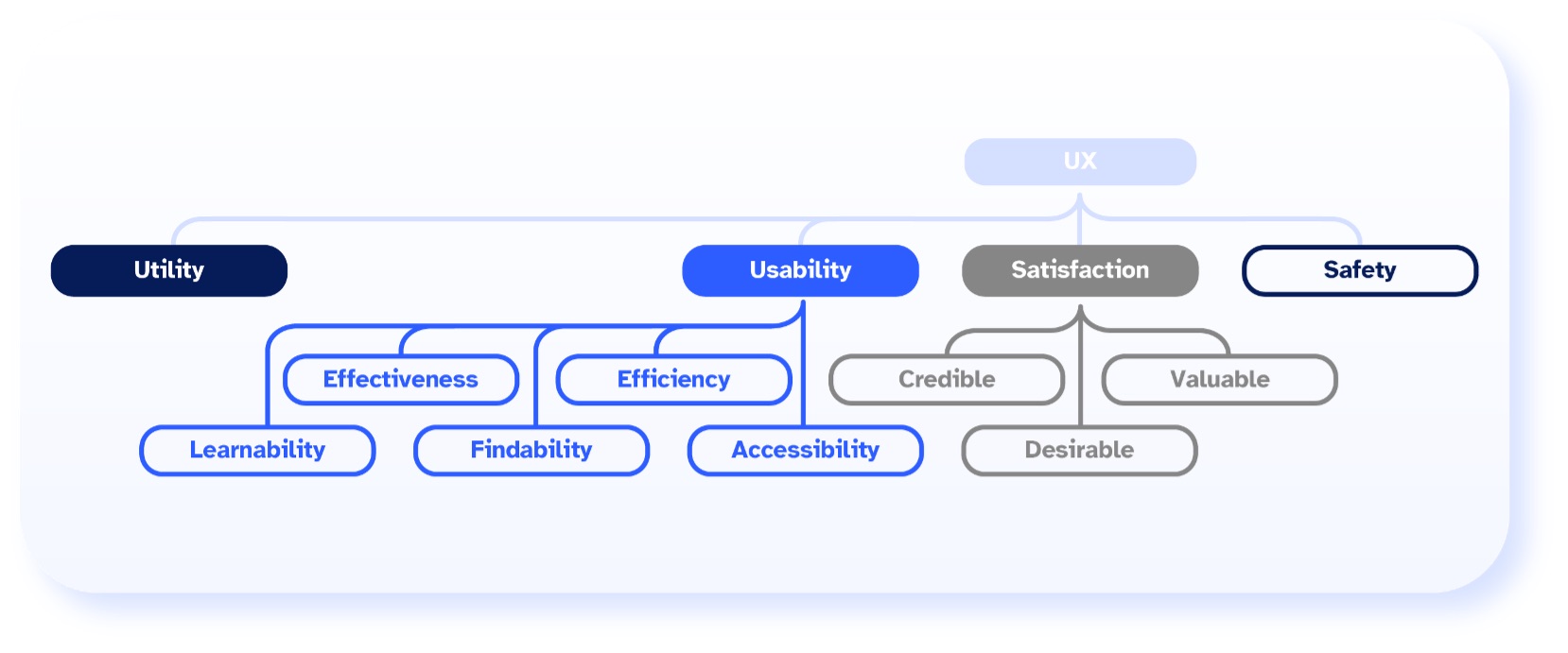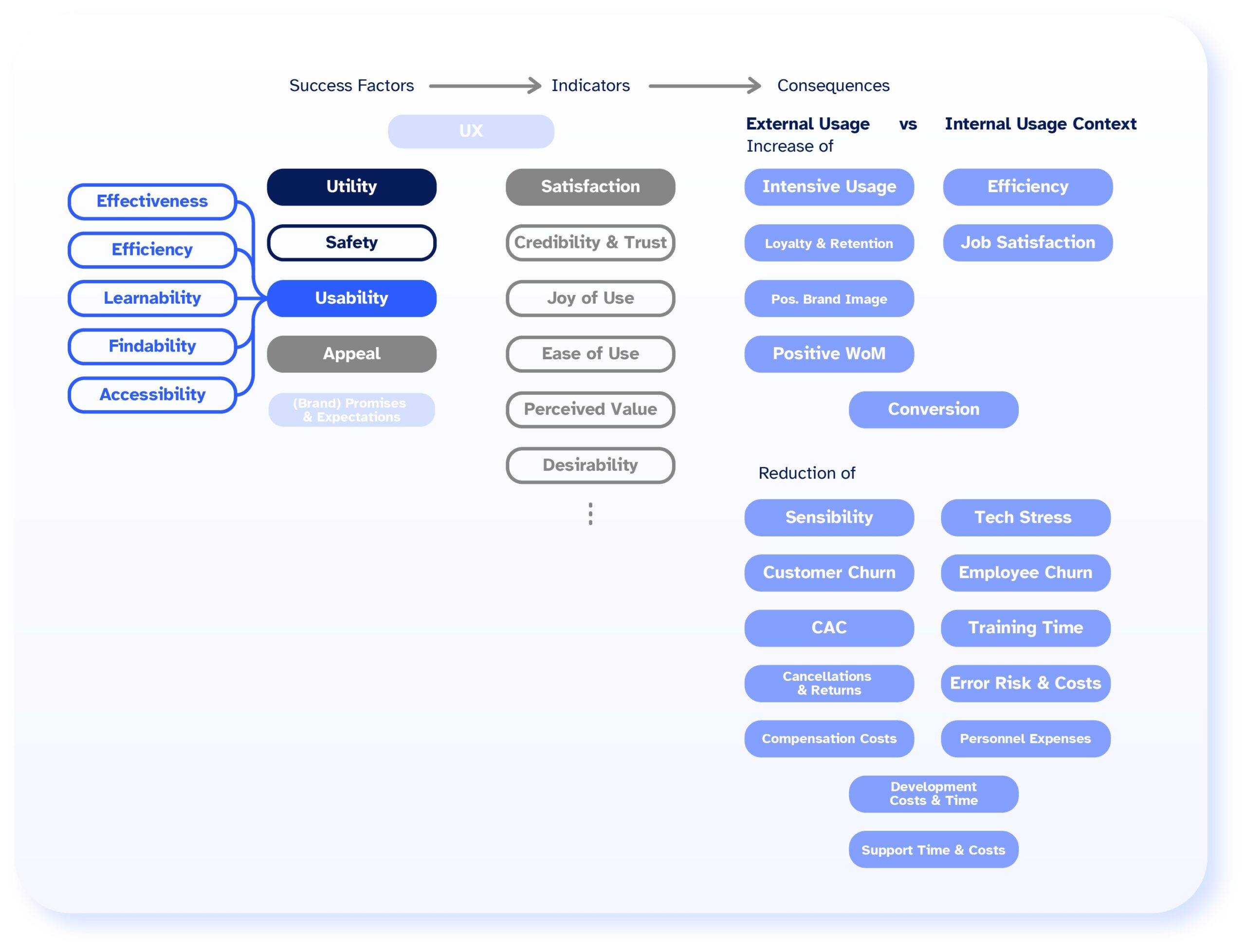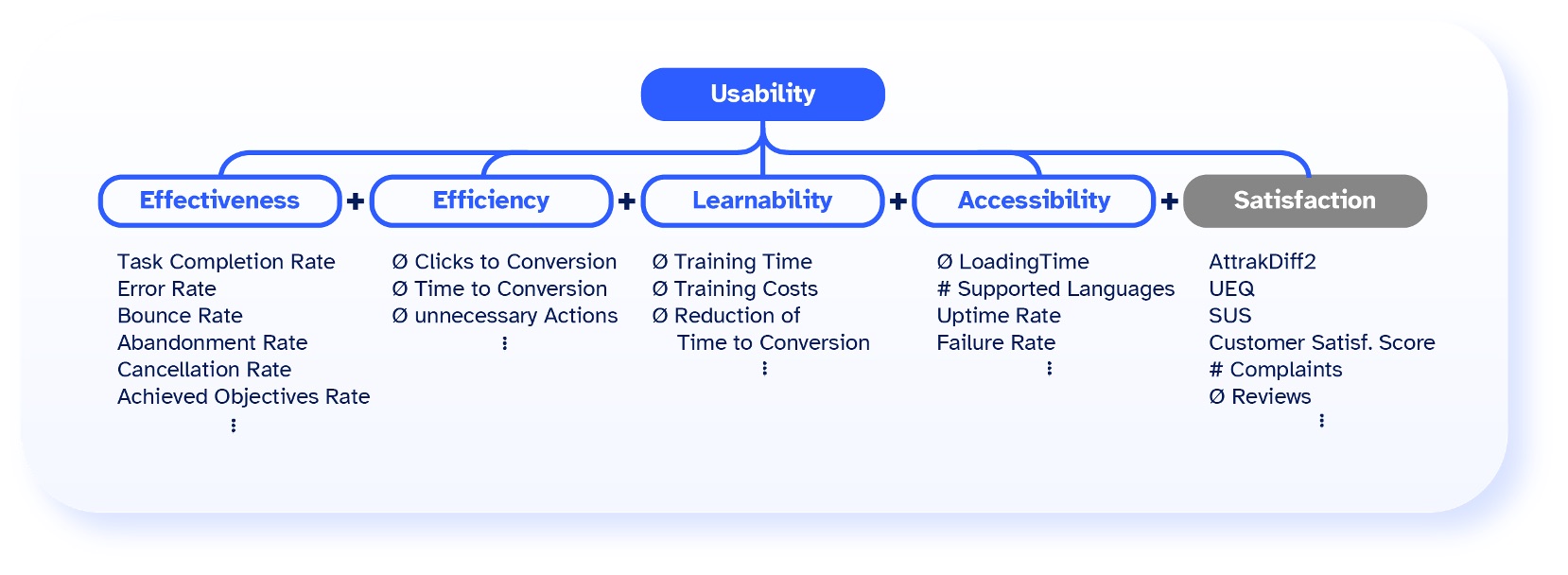The understanding and acknowledgment of the relevance of User Experience (UX) varies widely between business customers. The customers’ needs regarding information content are not standardizable. Thus, suppliers often struggle with the communication of User Experience in B2B sales. Therefore, the business customers‘ behavior and their information requirements, with a focus on UX, must be examined. The customers’ understanding of UX principles and the role differences within a buying center must be understood. By this, best practices of existing showcases derived to approach this issue of presenting User Experience in B2B sales. In my master’s thesis, I explored the topic through qualitative research and developed action recommendations for IT service providers.
In this article, I explain the theoretical background of UX sales. Further, I point out important arguments on UX, and present the action recommendations based on my research.
Understanding the dynamics of B2B buying
In the B2B landscape, purchasing decisions are complex, involving multiple stakeholders from various departments, and typically cause high costs. Hence, the consequences of a buying decision are severe. Such decisions, while largely rational, are influenced by personal and emotional motives. Thus, options typically are evaluated by a “buying center“ that considers various business goals, technical requirements, and user impact.
For software purchases, the buying center includes business decision-makers, domain experts, IT decision-makers, end users, and sometimes external consultants. The business decider focuses on aligning solutions with business goals, while the domain expert ensures project benefits and long-term success. The IT decision-maker, however, evaluates technical aspects like security and integration, and the end user assesses productivity and usability impacts. External consultants may provide additional insights and recommendations.
Nevertheless, as not all roles are involved in every decision-making phase, it is challenging to identify role structures within the buying center and to strategically distribute content across the right channels. Despite this complexity, understanding and addressing each persona’s requirements is essential for a successful argumentation of User Experience in B2B sales.
Creating seamless solutions: from utility and usability to UX
Utility, usability, and UX are critical components in software design and development: Utility refers to a software’s ability to solve specific problems which is essential for user acceptance. Usability, in contrast, is defined by ISO standards and focuses on a software’s effectiveness, efficiency, and user satisfaction, ensuring a seamless user flow across the interface. These elements must be integrated from the start of development to avoid user rejection.
UX extends beyond utility and usability, referring to the entire user interaction with the software and brand. Thus, UX includes aspects like flexibility, safety, and visual appeal, aiming to meet both pragmatic and hedonic user needs. Morville’s UX honeycomb highlights the importance of software being findable, valuable, and credible, among other factors. An overview of important factors of UX based on the ISO Standard and the UX Honeycomb is presented in the following figure.

The importance of UX in B2B software
In B2B environments, UX is often undervalued despite its significance. While B2C focuses on hedonic enjoyment, B2B prioritizes functionality and efficiency. Typically, in a pure B2B context, software is used by a company’s employees who are professionals using software for productive purposes rather than enjoyment. Hence, the UX of internally used software is not considered particularly necessary to invest in. However, employees‘ increasing expectations for positive UX, influenced by their personal experiences, necessitate attention to both functional and emotional aspects. Investing in UX can enhance productivity and engagement, although it may require initial costs and process adaptations.
Ultimately, understanding and implementing UX design in B2B contexts is crucial for both internal productivity and creating engaging experiences for end users. In the following figure, it is shown how UX shows and, in consequence, how metrics change both within external and internal UX software changes.

Detecting and utilizing the potential of UX
Both for internal use and external provision, UX has various positive effects. For detecting its potential, Bevan (2008) distinguishes between formative measures, which provide qualitative insights for understanding and action, and summative measures, which offer quantitative comparisons. Objective aspects like productivity increases can be measured with metrics, but subjective elements like satisfaction are more challenging. Various questionnaires, such as the User Experience Questionnaire (UEQ), AttrakDiff2, and System Usability Scale (SUS), are used to capture these qualitative aspects.
Choosing sufficient metrics to measure the effect of UX
Despite the challenges of quantifying UX, metrics can be gathered by analyzing user behavior data, such as traffic and conversions. It’s important to identify key metrics and use this traffic data to objectively demonstrate its implications for effective purchase decisions on the one hand and sales argumentation on the other hand. Three main frameworks are used to define sufficient metrics: the basic quantitative model of usability, PULSE, and HEART frameworks. The PULSE framework includes metrics like Page Views, Uptime, and Earnings. The HEART framework focuses on Happiness, Engagement, Adoption, Retention, and Task Success. Companies should choose metrics that align with their goals, using a Goal-Signals-Metrics approach (defining goals, determining signals that indicate the process to these goals, and choosing metrics to measure the progress) to track user behavior effectively.
The deepest insights, however, are provided by the combination of formative and summative measuring to both cover qualitative, subjective, and quantitative, objective aspects. An overview of possible metrics and questionnaires that can be combined and used by companies is given in the following figure.

Typical benefits of a positive UX
UX offers numerous benefits, such as increased perceived value and process improvements, leading to higher sales and reduced costs. Forrester Research estimates that every dollar spent on UX design returns $100. A well-designed UX reduces sensitivity to price, errors, and loading times, enhancing user satisfaction.
In B2B contexts, better UX can boost employee satisfaction and productivity, impacting the customer experience positively. Satisfied users are more likely to remain loyal and recommend the product, reducing marketing costs. Furthermore, improved UX also minimizes errors and training time, lowering personnel expenses.
An iterative, user-centered development process ensures that functionality meets user needs, saving development time and preventing costly product failures. Although concrete numbers on UX impact are rare, as they can vary strongly depending on the context, its potential benefits underscore the importance of investing in UX methods. By this, they can support the communication of User Experience in B2B sales.
Recommendations of action
Within the research, I reflected on the challenges of the communication of User Experience in B2B sales. Therefore, I conducted expert interviews to explore the gap in understanding the interplay between buying center structures, UX maturity, and customer segmentation. Ten inovex experts in sales, marketing, UI/UX design, and development were questioned.
Derived from the study’s results, the following recommendations aim to improve UX sales communication. The recommendations consider the customers’ UX maturity, sales process structures, buying center implications, and requirements for a UX showcase.
Foster the exchange and integration of various teams
In the context of UI/UX design, a gap often exists between design teams and the sales process. Designers, who are experts in creating engaging user experiences, typically remain under-involved in sales activities, missing out on key customer feedback. This means that they are only consulted in projects that explicitly focus on UX, where their expertise to negotiate specific design details is asked, rather than communicate the broader benefits of UX.
However, designers might not always have the sales skills necessary to deal with the complexities of deal-making. To address this, fostering regular collaboration between marketing, sales, and design teams is crucial. Schulz (2021) and Prath (2021) highlight that operational departments often operate in silos. They advocate for closer alignment to enhance marketing materials, content, and sales strategies.
By sharing market insights and customer needs with the design team, businesses can craft customized UX presentations that engage clients. Educating sales teams and developers on the value of UX can further unify understanding and boost persuasive efforts. Breaking down these silos can significantly enhance the persuasiveness of UX, ultimately leading to more successful customer engagements.
Adapt UX material to meet the customer needs at every stage
Navigating the complexities of customer engagement requires a nuanced approach, especially when traditional segmentation models fall short of providing UX insights. Thus, the material must align with both the customer’s lifecycle (CLC) stage and their UX maturity. The UI/UX design team must therefore develop a flexible pitch deck that caters to different maturity stages. This allows for addressing specific challenges and providing relevant solutions at every level. The materials must be designed for quick customization, allowing to mix and match elements to suit individual customer needs.
For customers at the initial stages, the goal is to build awareness. With visual material like two-pagers, the corporate website, and engaging social media posts the abstract UX concepts can become tangible. These materials should explain the basics of UX, its key benefits, and how companies ensure a user-centric approach simply. Therefore, it seems sufficient to tailor the language, introducing ‚UX‘ only when the customer is open to it, and switching to similar wording without catering to design stereotypes.
Furthermore, argumentation must be supported with data-driven insights, showcasing how UX improvements directly address the customer’s challenges. By collecting metrics from various projects, providing compelling evidence of a company’s solutions‘ effectiveness becomes possible.
Adjust the customer segmentation model
Customer segmentation in a B2B context, especially when providing custom software developed for a project, is a difficult topic. As each request, need, and customer background is unique, customer segmentation seems almost impossible. Even though a maturity or customer lifecycle model should be handled with care as data is reduced and generalized, combining those models might provide insights that allow approach one’s customers personally.
Keeping this in mind, both the sales and the UI/UX design team should work together on a segmentation model. This can, e.g., consist of the original (possibly 1-dimensional segmentation model) and a crawling tool that extracts posts and reactions of companies and the contact person conducting a sentiment analysis. By this, clues on how the customer company as well as their contact person perceives UX or other agile topics could be gained, the UX maturity vaguely rated, and insights in which wording to use or what methods to suggest could be derived.
Provide a suitable UI/UX service site
Being explicitly mentioned within several interviews, the most important need seems to be to increase awareness before the customers enter a sales meeting and to develop a way to argue the topic on this basis. Hence, the topic should be placed and linked prominently on the corporate website along with other services provided.
Most customers’ UX maturity is rather low. However, the lack of understanding decreases the chances of considering investments in its methods. Thus, the priority should be to create a basic understanding of UX, and, at the same time, provide convincing arguments of its relevance. This includes explaining the term and important aspects of UX, as well as optimization potential, and showcasing a project roadmap to illustrate how a UX process could look like from start to end and ideally include a case study that explains the advantages of UX methods.
A/B versions of features or screens can be shown to make the difference visually tangible and integrate the visitors cognitively. Therefore, exemplary wireframes of the UI/UX case studies could be embedded into the blueprint and explanations of the impact of the UX methodology can be shown. Additionally, all successful UI/UX case studies can be linked and exemplary KPI optimization can be connected to interactive elements. By this, the customers can see the individual potential of UX methods at a single glance.
Future implications
To optimize the persuasive power of communicating the value of UX, companies need to dive deep into understanding their customers’ individual needs. This involves refining their customer segmentation model and integrate further dimensions like sentiment analysis to capture more insights.
Further, in terms of user-centricity, it is crucial to go beyond the experts‘ perspective and listen to them directly. Conducting both qualitative and quantitative research will provide comprehensive and significant insights into affected people the customers‘ perspectives.
In addition, the effect of UX on various measures varies widely depending on the context. To provide customers with information on the effect of UX, each company should measure the success of previous UX projects. Additionally, long-term studies on how UX investments impact customers’ business success can offer further compelling selling arguments.
Overall, the insights gained by this research provide actionable insights, especially for IT businesses offering custom software. On this basis, providers can start working on optimizing their communication of User Experience in B2B sales. Considering these insights, businesses can meet the rising expectations of all users and grow in a competitive market.



